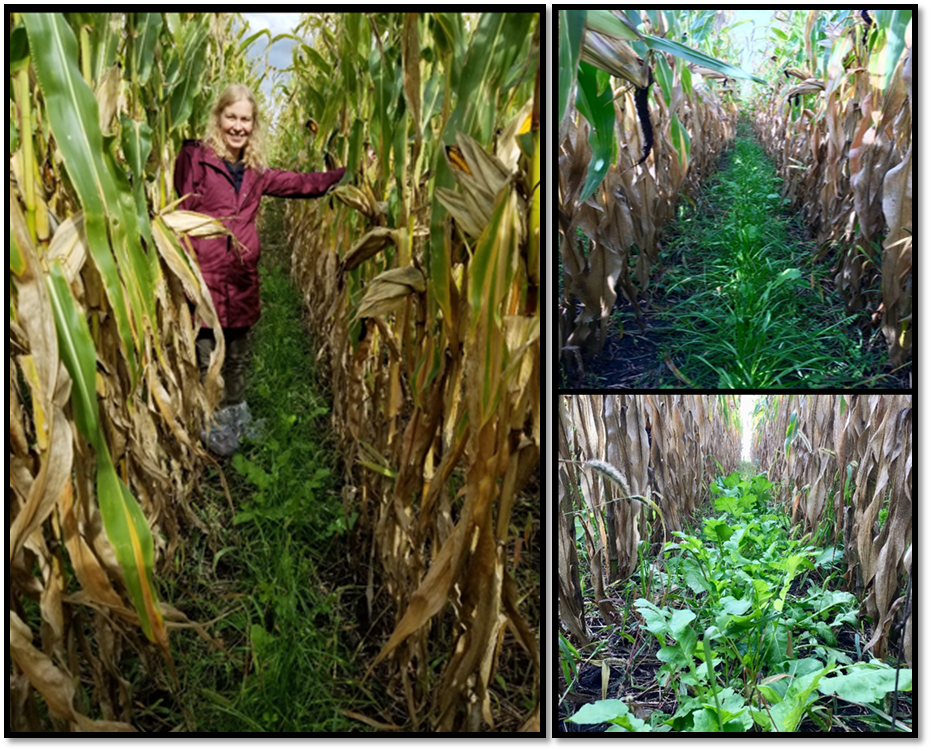Can including high protein forages with corn improve winter grazing practices leading to improved beef cattle health and environmental footprint?
| Project Code: | POC.08.18 |
| Completed: | March 2020 |
Project Title:
Exploring corn intercropping strategies to increase protein and profitability of beef cattle grazing
Researchers:
Emma McGeough, PhD and Yvonne Lawley, PhD (University of Manitoba)
Background
Approximately 68% of producers in Western Canada currently utilize some form of extended winter grazing. These winter grazing practices allow producers to reduce overwintering costs due to lower inputs and labour. Corn grazing is a popular method of winter feeding for a number of reasons including its very high yield per acre compared to cereal crops or forages, high energy content and it potential to provide shelter for cattle. However, corn is low in protein thus supplemental protein is required to maintain cattle performance particularly under cold weather conditions. The ability to graze other high protein forages between the rows of corn provides the opportunity to reduce the need for protein supplementation. This practice may also have the potential to provide high quality feed for classes of cattle whose level of performance may be limited by the low protein content of straight corn such as backgrounding cattle. Extending the grazing season by maintaining beef cattle on pasture in late fall/winter has been adopted by many Prairie producers as it significantly reduces labor and feed costs compared to confined feeding.
Objectives
To identify new combinations of corn grown with high yielding, high protein forages for improved fall grazing.
What they did
Researchers planted four different types of high protein crops between the rows of corn: Italian ryegrass, hairy vetch, radish, and clover, as well as a mix of all four crops. A control crop of just corn was also planted. As nitrogen fertilizer is one of the most expensive inputs for corn systems, each of these intercropping combinations was compared under low (40lbs/acre) and high (100lbs/acre) nitrogen application levels. The corn was seeded in May and the intercrop was seeded when corn had reached the V4 stage (when the 4th leaf collar is visible).
Measurements on plant establishment, corn and intercrop yield, and nutritional value (crude protein, TDN, fiber) were conducted in October and December to evaluate the potential of the intercropped corn as a potential overwinter feed for beef cattle. Corn-intercrop treatments further evaluated to assess the ability to meet nutrient requirements of cattle classes, using CowBytes Beef Ration Balancer.
Manitoba Agriculture and Resource Development Farm Management 2020 Cost of Production tools for crop production, farm machinery and beef cow-calf were used as guidelines for cost of production estimation for all others costs associated with growing corn vs. corn intercrop treatments.
What they learned
Intercrops were successfully established between corn rows in 2019 under drought conditions. Corn grain yields were low and there was no grain yield response to the higher rate of N fertilizer under the drought conditions. The presence of the intercrop treatments did not reduce corn grain yield relative to the control. At one site, intercrop treatments that included nitrogen fixing legumes (clover, vetch, mix) had higher yields relative to the control treatment.
Although nitrogen application rate did not increase grain yield or forage biomass, it did increase CP content from 20.5% (low N) to 22.3% (high N) averaged over intercrops and sites. Intercrops ranked similar in crude protein content at both sites and on average Graza Radish had the highest (29%), and Clover the lowest (13.2%), and the remaining crops with intermediate amount (21.7%). Although crude protein content varied among intercrops, the levels exceeded the requirements of gestating cows, replacement heifers, and backgrounding steers (NRC, 2000), suggesting the value of these crops as protein supplement to low quality forages such as whole corn.
The TDN and crude protein content of corn were not affected by presence of intercrop forages, however the latter was increased with high vs low nitrogen application (6.6 vs 7.5% crude protein). When evaluated in combination given the measured yield of each, the total available forage (corn plus intercrop) met protein requirements of mature beef cows at high nitrogen treatment, and corn with Graza Radish and the four species Mix at low N, but did not meet requirements of heifers and backgrounding steers under the conditions of this study.
Intercropping treatments increased production costs by $115 to $350/ac for seed and equipment use associated with the intercrop. Among the intercrop treatments, the costs of production were ranked from highest to lowest as follows: Hairy Vetch>4 Species Mix>Graza Radish>Italian Ryegrass>Red Clover. These relative costs are driven by the seeding rates selected for the study and 2019 seed costs, which may vary.
What it means
Dry matter yield for all intercropped forages and the mixture were lower than expected at both locations, due to the drought conditions during 2019. However, under these stressful conditions the intercrops successfully established. Given the high crude protein value of these intercropped forages, further evaluation of intercropped corn under non-drought conditions is warranted. Additional assessment of new agronomic practices to increase the yield of the intercrop in combination with the corn (such as wider row spacing or reducing corn populations) may enable corn intercropping to offer high quality overwinter feeds for cattle across western Canada. This proof of concept project showed that intercropping legumes with corn can provide the dietary requirements for cows. Next steps include determining how cows respond to grazing these crop mixes.

Figure 1. High protein forage intercrop mix of Graza Radish, Hairy Vetch, Italian Ryegrass and Red Clover growing in between corn rows in September, 2019 at Kelburn Farm (left) and Carman (right).








